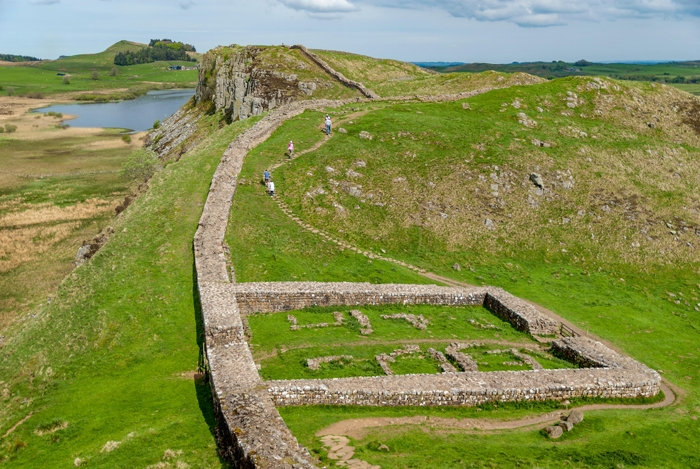Maybe it was all the recent talk of walls and borders. Maybe the sensation of edges and boundaries reinscribing themselves around us. Or perhaps it was the hope that following a single simple instruction for a week might give some sweet relief from all of the above. Whatever it was, we found ourselves in a Travelodge in a flimsily regenerated zone in Newcastle ready to walk the length of Hadrian’s Wall.
The wall was, as you probably know, the northernmost border of the Roman Empire, the hightide mark of a long-ago-receded ambition, Rome’s enthusiasm for subjugation having petered out just beyond Carlisle. Still, garrisons were established to dramatise this edge-of-empire: first as a turf mound, then as a complex set of ditches and finally a 3.5m-high stonewall. The wall stretches 135km: it runs from (almost) the eastern coast of England to an estuary in the west. In its nation-crossing scale and its singular purpose of articulating the threshold between ‘in’ and ‘out’, it is architecture in its purest form – both a simple wall and an ideology imposing its will on the natural world. At least, that’s what it once was.
Large parts of it are no longer in place; they exist as little more than a dotted line on a map and a set of well-maintained signposts. In other places its presence is hyperreal, a broad dark mass that snakes abstractly over the jagged topography of Northumberland.
But whether present or absent physically, it is always there conceptually: a triple whammy of the fantasies of radical architecture collective Superstudio, British ‘walking artist’ Richard Long and US President Donald Trump.
Long divorced from the geopolitics that dictated its construction, the wall has shifted from military infrastructure to heritage-asset-slash-leisure-industry: no longer a north–south border, but an east–west route. A historic line that now offers a random slice through contemporary Britain: starting in the abandoned shipyards of the Tyne, full of postindustrial buddleia, through the stag- and hen-night-packed centre of Newcastle, out through call centres, car dealerships and suburbs, before eventually opening up into the vast landscapes of Northumberland National Park.
Even out here the line reveals territories as it cuts through different conservation regimes. Mostly, when cared for by the National Trust, walking on the wall is forbidden. In English Heritage’s section you are forced to walk on it. When you remember that English Heritage was a Thatcherite invention intended to monetise conservation, a kind of independent television to the National Trust’s BBC, it sort of makes sense.
Draw a line on a map and something strange happens… The line glides across this surface with the frictionless freedom of abstraction. With such apparent ease, the graphic reorganises the geographic
Draw a line on a map and something strange happens. The tip of the pen leaves a trail of ink staining the symbols and contours on the page. There’s no tripping or stumbling. The line glides across this surface with the frictionless freedom of abstraction, not getting snagged in the undergrowth, caught on crags or bogged down in marsh. With such apparent ease, the graphic reorganises the geographic. You would think that, as an architect, I would be used to this kind of thing. But I’m not. Every time I look at a floorplan, I am consumed by the ambiguity of the mark. Is the width of the line real? Is the real line in the middle of the drawn line? Is the authority of the line the actual mark or the concept to which it refers?
Maybe there’s always a confusion between the map and the territory. Sometimes that space even becomes something: houses have been built on the territory covered by the thickness of a line on a map, interpreting the width of the boundary of some form of no-man’s land between the owned territories it was intended to describe.
Back on the wall, there’s always a tension between its authority and its dissolution: in moments such as the encounter with a still-standing arch that retains its power as a gateway between civilisation and the free folk (or however else you want to characterise it), or when contemplating the stones plundered to take on new lives as farmhouses, huts or other structures, or which sank back into the earth, or have been taken home as souvenirs in Gore-Tex pockets. In all those ways the abstract order of the wall has been smudged, smeared and finally returned to the landscape.
That offers some comfort in our border-obsessed times: even the most extreme gestures dissolve; every authority is susceptible to ruin.
Sam Jacob is an architect. This article is the first of a new series of column published in ArtReview under the title ‘The Shape of Things’, in which its author explores form outside of the art gallery
From the October 2019 issue of ArtReview
